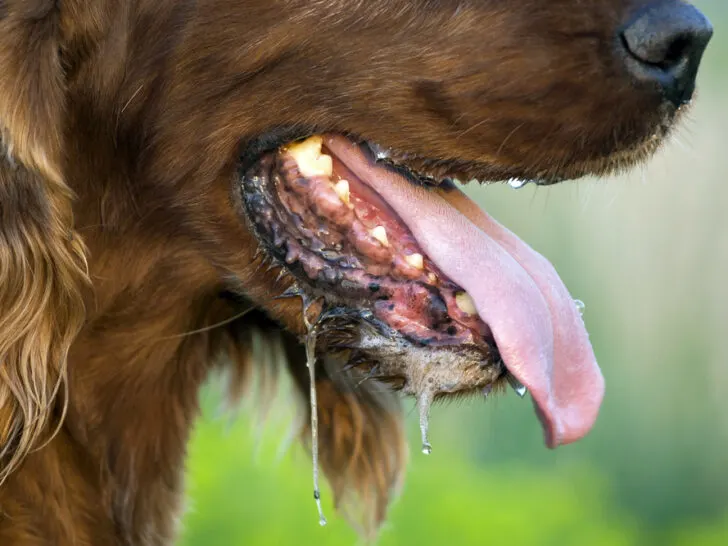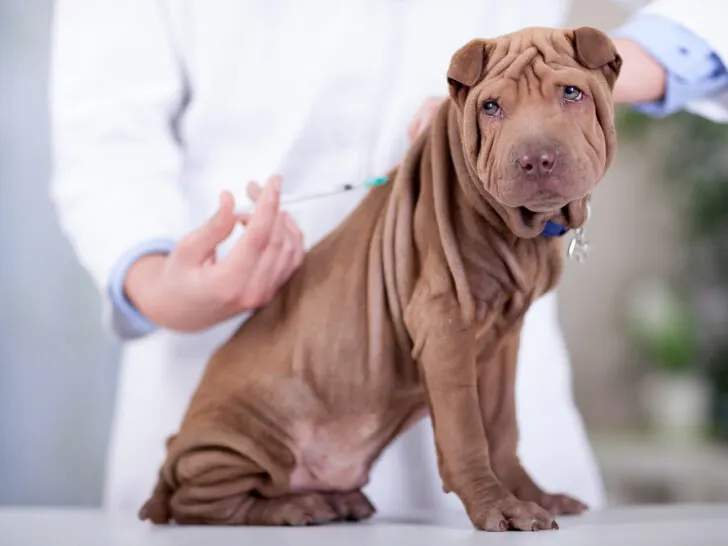Medically Reviewed by Dr. Majid Tanveer, DVM
As an adoring pet parent, it’s natural to be concerned about the probability of rabies in your precious pup. Thankfully, there are several protective measures that you can take to help protect your furry friends from this frightening virus.
As a veterinarian, I know that being up to date on recognizing the signs and symptoms of canine rabies is essential – as well as how to keep your pup safe from this lethal virus.
Rabies is a fatal virus that can lead to severe neurological harm and death in animals and humans if left untreated. Symptoms of rabies in dogs can include aggression, depression, fever, paralysis, and strange vocal or physical movements. Vaccination is the most effective way to protect your pup from rabies and avoid unvaccinated animals or wild creatures that may carry the virus.
Let’s take a closer look at the signs, prevention methods, and vaccine protocols for rabies in dogs.
What is Rabies in Dogs?
Rabies is a deadly viral infection that targets the central nervous system of dogs and other mammals. It is caused by a virus belonging to the family Rhabdoviridae, which spreads through contact with saliva or brain tissue from infected animals.
Every mammal is vulnerable to rabies, including domestic and wild animals like dogs, cats, cows, horses, raccoons, skunks, foxes, and bats that carry different virus variants.
Even though an animal may look healthy and not display any symptoms of infection, it could still be a virus carrier and pass it along to humans or other animals. It is integral to comprehend this risk to avoid potential transmission.
Annually, 400-500 cases of rabies are reported among home animals like cats, dogs, and ferrets. Fortunately, a simple vaccination can quickly provide 100% prevention from rabies.
How Is Rabies Transmitted in the Dog?

Rabies is primarily transmitted from the saliva of an infected animal and most commonly occurs through bite or nail scratch, as nails may carry the virus from licking. When an infected animal bites another animal or person, the virus can travel through tiny cuts in their skin, allowing it to enter their bloodstream.
Once introduced into the body, the virus rapidly migrates to the central nervous system, where it begins replicating. From there, it travels outward through peripheral and sensory nerves, eventually reaching other body tissues, particularly in salivary glands, to reside permanently.
The virus’s incubation period can vary between three to twelve weeks, with no visible symptoms. However, once it invades the brain and quickly reproduces itself, inflammation can occur, resulting in swelling of neurological tissue, which may eventually cause severe damage.
This destruction can result in many neurologic manifestations, such as aggression, biting, convulsions, or difficult respiring.
Following an animal bite, rabies progresses in stages. During the prodromal phase, dogs may become agitated or shy – this could last 2-3 days. It is then classified into two forms: furious and dumb.
- Furious Form: Dogs become aggressive and have a depraved appetite for objects such as stones or rubbish. They eventually become paralyzed and die in a seizure.
- Dumb Form (Paralytic Form): In this form, paralysis sets in gradually, causing facial distortion and difficulty swallowing. The dog ultimately falls into a coma before expiring.
Symptoms of Rabies in Dogs

Rabies in dogs is a severe, life-threatening virus. It’s essential to recognize the symptoms, take preventive measures, and act quickly upon signs of infection.
A rabid dog has little chance of survival, but recognizing it early could save your pet’s life and your own since rabies is zoonotic. Familiarize yourself with this situation and be ready to act at the first signs of infection!
Fever
Dogs with rabies may have a fever and increased thirst. This is due to the virus breaking down their body’s defenses and causing an increase in temperature.
Aggression
A dog with rabies may act unusually aggressively, growling or barking at people or animals with whom it would typically be friends. It may also become exceptionally defensive and try to bite when handled.
Depression
Rabies can cause dogs to display drastic changes in their behavior, including depression and general sluggishness. They may suddenly become uninterested in activities they used to find pleasurable or have difficulty just going for a walk.
Unusual Vocalizations
Dogs suffering from rabies may make sounds they usually wouldn’t, such as loud yelps, howls, or screeches. The cause of this is due to the virus causing inflammation in their vocal cords.
Unexplained Behavioral Changes
Animals will often exhibit a sudden behavior change when infected with rabies. This could include aggression, changes in sleeping patterns, or sudden bursts of energy.
Excessive Drooling, Salivation, or Foaming at the Mouth
Rabies-infected dogs cannot swallow saliva due to paralyzed throat muscles, leading them to drool and secrete more than usual. This inability of the dog’s throat to close completely renders it impossible for these dogs to manipulate the amount they salivate.
Abnormal Eye Movements and Blinking Patterns
Rabies can cause muscle paralysis, including the muscles of the eyes; this leads to abnormal movements, such as flickering or twitching. Your dog may also have difficulty focusing his eyes. In severe cases, your dog may become blind from the virus.
Difficulty Swallowing, Eating, or Drinking
Trouble in ingesting solids and liquids may be an early warning sign of rabies within dogs. This can largely be attributed to paralysis of the throat muscles, making it arduous for them to consume or drink adequately.
Loss of Coordination or Balance Problems
This virus can disturb the nervous system, causing diminished muscle strength and impaired coordination. Henceforth, it will be difficult for dogs to walk or stand with stability and increased clumsiness.
Disorientation or Confusion
As the virus ravages their cognitive functions, rabid dogs may display signs of disorientation or confusion. This could manifest in them spacing out, aimlessly wandering, wildly running around as if lost and without a purpose, or appearing completely dazed.
Paralysis
Rabies can cause severe muscular paralysis in the face, jaw, and throat – impairing an individual’s ability to move or eat correctly. It could also manifest as drooling and abnormal vocalizations; in more extreme cases, it may even lead to paralysis of the hind legs.
Remember that some dogs affected by rabies may not display any evident symptoms, so it can be hard to detect on your own. However, if you observe any of these signs in your furry friend, immediately ensure they receive medical assistance.
How Is Rabies Diagnosed and Treated?

Rabies is a deadly dog virus that can be difficult to diagnose accurately. The only way to confirm a diagnosis of rabies infection is by performing an autopsy, which involves taking brain tissue samples from the deceased animal.
Sad as it may be, rabies is untreatable and requires euthanizing your pup once diagnosed. That’s why vaccinating against the virus should always be a priority – taking proactive steps to protect them from this deadly disease can save their lives in the long run!
Rabies Vaccination
Rabies vaccination is a preventive measure to protect pets from the deadly virus. It introduces a weakened form of the virus into your pup’s body, allowing his immune system to recognize and respond to it before it causes severe damage.
Regular vaccinations help create an immunity barrier and boost antibodies against the virus, protecting your pet in case of contact with a rabid animal or other exposure.
Building immunity takes roughly 28 days after the initial injection, so it’s essential to ensure your pup receives a follow-up vaccine three weeks later for complete protection.
Types of Rabies Vaccines Available
| Product Name | Manufacturer | Vaccine Type | Route of Administration | Age For Initial Dose | Duration Of Immunity |
| NOBIVAC | Merk Animal Health | Killed | S/C or IM | 3 months | 1-3 Years |
| DEFENSOR | Zoetis | Killed | S/C or IM | 3 months | 1-3 Years |
| RABAVAC | BoehringerIngelheimVetmedica | Killed | S/C or IM | 3 months | 1-3 Years |
| IMRAB | BoehringerIngelheimVetmedica | Killed | S/C or IM | 3 months | 1-3 Years |
Recommended Schedule for Vaccination Against Rabies
Rabies vaccinations usually involve two injections: an initial dose and a booster three weeks later to ensure complete protection. This is typically done when your dog is between 3 to 4 months old; however, any age can be vaccinated with the appropriate rabies vaccine.
- 1st dose: At the age of 3 months
- 2nd dose: After 21 days of the first dose
- Booster dose: Repeat every year
Rabies vaccinations may vary depending on the type of vaccine and local government laws. It’s essential to check with your local government for the specific requirements in your area before scheduling a rabies vaccination for your pup.
Working with your veterinarian, you can ensure your pet has the best protection against this potentially fatal virus.
Post-Exposure Vaccination Schedule
| Vaccination Status | Type Of Confinement | Vaccinate |
| Never Vaccinated | Euthanize 4 months of strict quarantine | N/A Vaccinate within 96 hrs |
| Currently Vaccinated | Under owner’s observation for 45 days | Booster |
| Out-of-date and documented | Under owner’s Observation for 45 days | Boster |
| Out-of-date and undocumented | Euthanize 4 months of strict quarantine Under owner’s observation for 45 days | N/A Vaccinate within 96 hrs Booster |
Prevention of Rabies in Dogs

Proactive measures like avoiding contact with wild animals and ensuring your dog are current on their vaccinations are the most effective prevention of a rabies infection. Taking these safety precautions beforehand can help reduce the risk before it starts.
Prevention will always be better than treatment for this virus, so don’t let yourself put off such essential safeguards for you and your pup!
Avoid Contact With Wild Animals
To guard against interaction with wild animals, it is imperative to avoid their habitats. Refrain from luring them into your home or environment, and constantly monitor your pet if they are outdoors.
Furthermore, be mindful of areas where unvaccinated pets have been seen venturing.
Maintain Your Dog’s Health
Ensuring your pup is at the peak of health with timely visits to a veterinarian and shots ensure his physical, emotional, and social well-being.
This way, your pup can handle contact with diseases like rabies or other illnesses while minimizing life-threatening risks.
Keep Vaccinations Up-to-Date
To ensure your dog is guarded against rabies, their vaccinations must be updated throughout all stages of life. Your veterinarian can administer the correct vaccines and ensure they meet local laws.
Vaccines are an excellent shield against rabies, yet staying attentive remains essential as there’s no 100% protection guarantee.
Supervise Your Dog when Outdoors
Supervision of your pup when he is outdoors can help to ensure that they stay away from any potential sources or carriers of rabies and potentially hazardous situations.
Consider a Leash or Fence
Consider setting up a leash or fence around your property to help keep your pup away from wild animals or other unvaccinated pets that may carry rabies.
Keeping a safe distance between your pup and any potential virus sources is vital in protecting them from harm.
In short, vaccinating your pup is the best way to protect him from rabies – but there are other measures you can take. Monitor his behavior for any changes and try to discourage contact with wild animals when out and about.
Always abide by local laws regarding rabies, as these exist to keep both animals and humans safe. By taking extra steps and keeping your pup’s vaccines up to date, you can help ensure they remain safe from rabies.
Pet Care Tip: Check out this video on how to leash train your dog. Always keep your pup on a leash and look out for wild animals or unvaccinated pets when going outside.
Frequently Asked Questions
Can A Vaccinated Dog Still Contract Rabies?
Although most vaccine companies promise a 100% success rate, failure can occur due to mishandling, improper storage, mistakes during administration, underlying health issues, and more. Incorrect sites of injection or cold chain disturbance may also cause vaccine failure. In any of these cases, the vaccination may not provide enough protection against rabies.
Can I Get Rabies From A Bite From My Dog?
Yes, any breach of the skin by teeth can transmit rabies. The risk depends on the species of animal, where it bit you, and how severe the wound is. Thus, all bites should be taken seriously and may require medical attention.
Do Dogs With Rabies Typically Avoid Drinking Water?
It is common for rabies to induce fear of water due to the physical pain associated with swallowing. As a result, as throat muscles seize up the cause of this virus, animals may quit drinking altogether and become dangerously dehydrated in no time.
